Enamel jewelry’s texture looks unique because you’re seeing powdered glass fused to metal at temperatures exceeding 1,380°F, creating a distinctive glass-like surface. The fusion process combines smooth, glossy finishes with dimensional boundaries formed by metal structures like cloisonné wires or champlevé recesses. Multiple firings build depth while metal oxides create vibrant colors that interact uniquely with the glass particles. Temperature control determines whether you’ll see granular textures or mirror-smooth surfaces, and techniques like plique-à-jour allow light penetration for luminous transparency effects that reveal the intricate craftsmanship behind these stunning pieces.
The Science Behind Enamel Glass Fusion
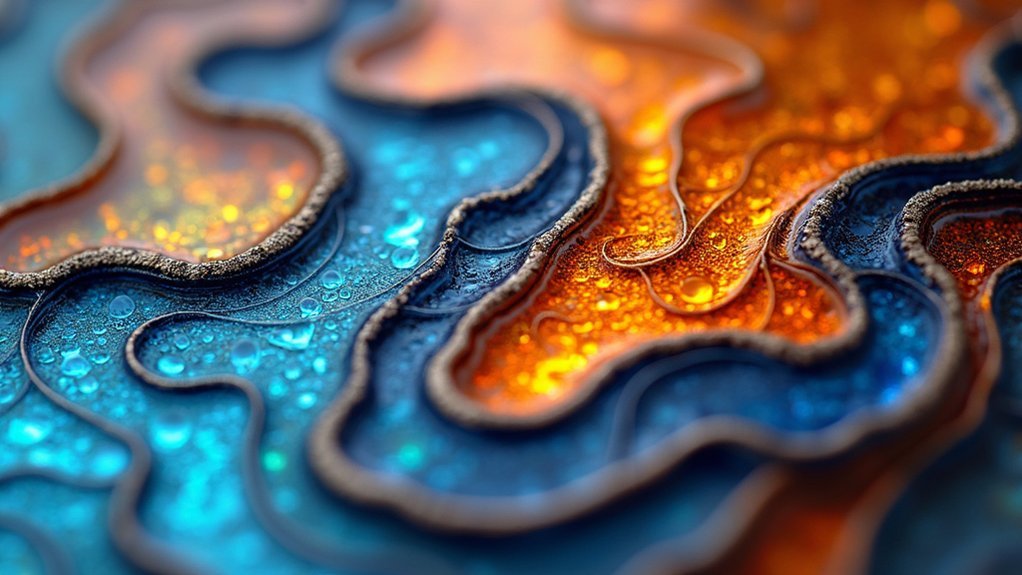
When artisans create enamel jewelry, they’re fundamentally performing a controlled chemical transformation that fuses powdered glass to metal through intense heat. This technique involves heating temperatures between 1,380 to 1,560°F, causing the glass particles to melt and bond permanently with the metal surface.
The glass composition contains quartz sand, metal oxides, and specialized additives that create distinctive colors and textures.
Metal oxides and quartz sand blend with specialized additives to produce the distinctive colors and textures that define enamel jewelry’s visual appeal.
You’ll notice that achieving vibrant enamel requires multiple firings—typically six or seven cycles—to build proper depth and intensity.
Temperature variations and your choice of base metal dramatically influence the final appearance. These factors determine whether your enamel becomes opaque or transparent, smooth or textured.
The controlled cooling process solidifies the molten glass into that characteristic smooth, durable finish that makes each piece visually striking and unique.
How Temperature Controls Surface Texture
Temperature precision becomes your primary tool for sculpting enamel’s surface character. When you fire enamel between 1,380 to 1,560°F, you’re directly controlling how the powdered glass fuses to your metal substrate.
Higher temperatures create glass-like smoothness and glossy finishes, while lower firing temperatures preserve granular, textured appearances that retain visual interest.
You’ll notice temperature affects more than just surface feel—it influences opacity and color vibrancy too. Multiple firing cycles at controlled temperatures let you layer different techniques for complex texture effects.
Each degree matters because it determines how the enamel flows during fusion. By mastering temperature control, you’re fundamentally choosing between creating sleek, mirror-like surfaces or maintaining the organic, varied textures that make each piece uniquely enchanting.
Cloisonné Wire Compartments Create Dimensional Patterns
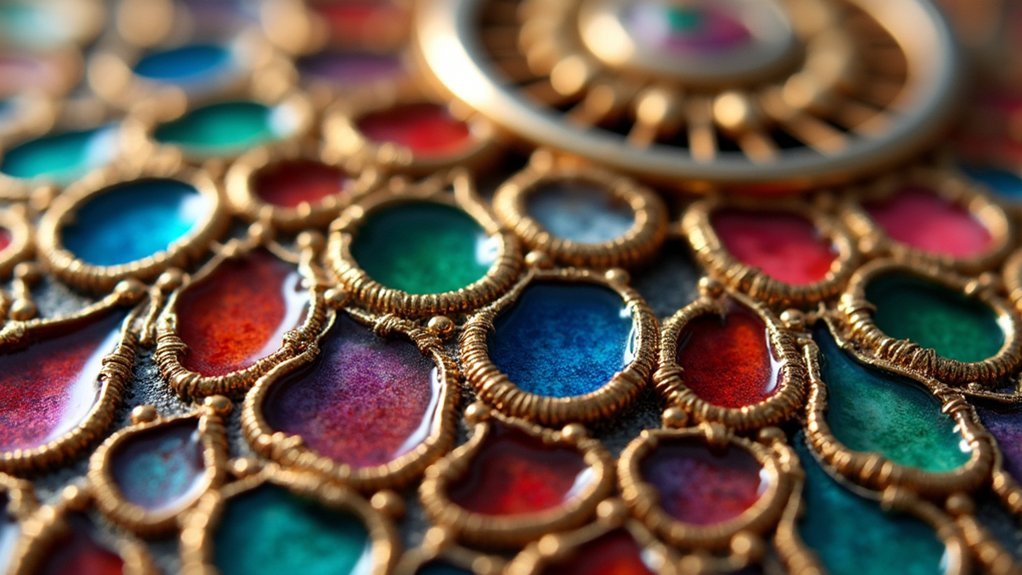
You’ll discover that cloisonné’s thin metal wires don’t just separate colors—they’re the architectural foundation that builds genuine three-dimensional texture into your enamel jewelry.
These wire frameworks create raised boundaries that compartmentalize the surface, transforming flat pieces into sculptural works with measurable depth and shadow play.
The metal compartments themselves become integral design elements, defining crisp geometric patterns while the filled enamel areas provide contrasting smooth textures within each bordered section.
Wire Framework Creates Depth
As artisans carefully position delicate metal wires across the jewelry’s surface, they’re creating the foundational framework that’ll transform ordinary enamel into extraordinary dimensional art.
This wire framework establishes depth and dimension by forming varying heights and compartment sizes that catch light differently across the piece’s surface.
The strategic placement of these metal barriers creates intricate enamel patterns with remarkable visual complexity:
- Individual wire heights determine how much enamel fills each section
- Compartment shapes influence light reflection angles and intensity
- Metal thickness affects the contrast between framework and enamel
- Wire positioning controls color separation and pattern definition
You’ll notice how this dimensional approach makes vibrant colors appear more saturated and defined.
The raised wire edges create shadow lines that enhance the piece’s sculptural quality, giving cloisonné jewelry its distinctive three-dimensional appearance.
Metal Compartments Define Patterns
Beyond establishing depth, these carefully positioned wires serve as precise boundaries that segment the jewelry’s surface into individual compartments, each destined to hold its own distinct color.
These metal compartments become the foundation for intricate patterns that define cloisonné’s signature look. You’ll notice how each wire-framed section can vary dramatically in size and shape, allowing artisans to craft everything from geometric designs to detailed imagery.
The compartmental structure gives you incredible versatility in pattern creation. Each bounded area holds powdered glass that transforms into vibrant enamel when fired, creating clearly defined color zones.
This segmented approach to design means you’re seeing texture that’s both visual and tactile, where the raised wire edges create physical boundaries between colors while enhancing the overall dimensional quality.
Champlevé Carved Recesses Add Tactile Depth
You’ll discover champlevé enamel’s unique appeal lies in its carved metal foundation that creates natural relief patterns.
The technique transforms flat surfaces into dimensional landscapes where recessed areas hold vibrant enamel while raised metal borders remain exposed.
This contrast between smooth, glossy enamel and textured metal surfaces gives your jewelry pieces an irresistible tactile quality that invites touch.
Carved Metal Creates Relief
Carving intricate recesses into metal surfaces transforms flat enamel jewelry into dimensional artwork through the champlevé technique.
You’ll notice how carved areas create striking relief patterns that elevate the visual impact beyond traditional flat designs. The varying depths you see in these recesses generate shadows and highlights that shift as light moves across the surface.
This champlevé method produces several distinctive characteristics:
- Variable depth carving creates multi-layered visual effects
- Raised metal borders frame each enamel section distinctly
- Textured appearance emerges from contrasting smooth and carved surfaces
- Tactile quality invites touch through dimensional differences
When enamel fills these carved recesses and fuses during firing, you get a permanent bond that preserves every detail.
This ancient technique continues showcasing how skilled artisans transform simple metal into sophisticated enamel jewelry with remarkable three-dimensional presence.
Textural Contrast Through Depth
When your fingers trace across champlevé enamel jewelry, the contrast between raised metal ridges and smooth, recessed enamel creates an immediate tactile experience that flat surfaces can’t match.
The carved depressions create varying depths that make each piece dynamically interactive with both light and touch. This textural contrast draws your eye naturally across the surface, where vivid enamel colors settle seamlessly into metal recesses.
You’ll notice how the champlevé technique transforms simple jewelry into sculptural art. The depth variations invite exploration, making you want to examine every detail.
This exceptional craftsmanship requires significant skill to carve and fill recessed designs properly. Each piece becomes unique through these dimensional qualities, where the interplay between raised metal and smooth enamel surfaces creates visual and tactile richness that elevates the jewelry beyond ordinary accessories.
Plique-à-jour Transparency Effects Through Light
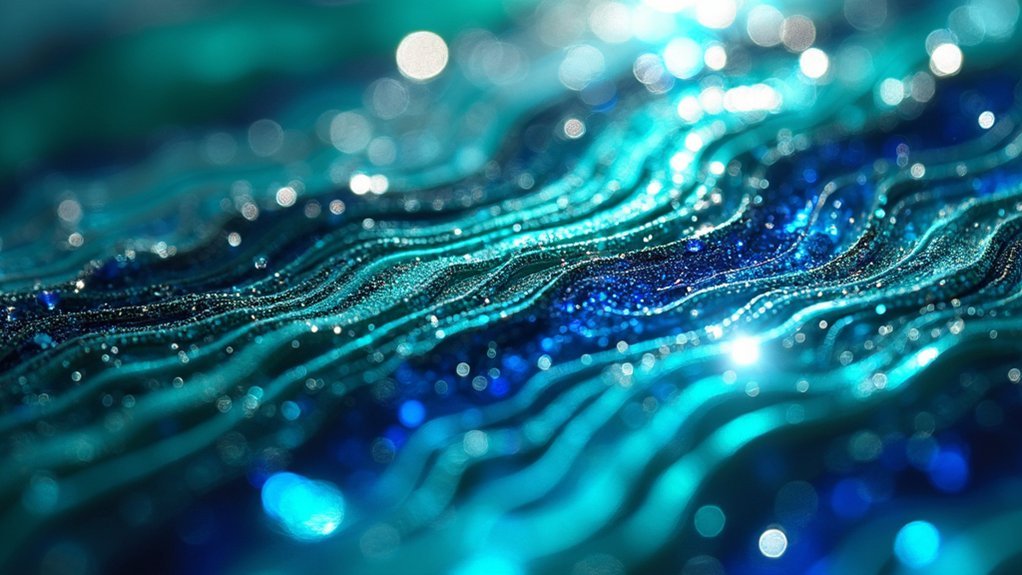
Light becomes the star performer in plique-à-jour enamel jewelry, transforming each piece into a miniature stained glass window that captures and plays with illumination.
Light dances through translucent enamel, creating luminous jewelry that glows like precious stained glass windows worn close to the heart.
You’ll notice how translucent enamel creates breathtaking visual depth as light penetration occurs without any metal backing to obstruct the glow. This sophisticated technique demands precise craftsmanship to maintain structural integrity while maximizing transparency.
The plique-à-jour technique creates stunning effects through:
- Light refraction – Colors shift and intensify as illumination passes through different angles
- Enhanced vibrancy – Translucent layers create richer, more saturated hues than opaque alternatives
- Dynamic visual depth – Multiple enamel layers produce complex color interactions
- Stained glass aesthetics – Compartmentalized designs mimic cathedral window patterns
This complexity makes plique-à-jour enamel jewelry highly coveted among collectors who appreciate exceptional artistry.
Metal Oxide Interactions Shape Color Outcomes
Beyond the enchanting transparency effects that make plique-à-jour so mesmerizing, the fundamental chemistry of metal oxides determines every color and textural nuance you’ll observe in enamel jewelry. When you examine different pieces, you’re witnessing specific metal oxides reacting under intense heat between 1,380°F and 1,560°F.
| Metal Oxide | Color Created | Emotional Impact |
|---|---|---|
| Cobalt | Deep Blue | Serenity, Trust |
| Chromium | Rich Green | Growth, Harmony |
| Iron | Warm Amber | Comfort, Strength |
| Copper | Vibrant Red | Passion, Energy |
These metal oxides don’t just create colors—they shape texture through their unique reactions with powdered glass. Different enamel techniques manipulate oxide concentration, creating everything from smooth, lustrous surfaces to richly textured finishes that capture light dramatically.
Firing Techniques That Determine Finish Quality
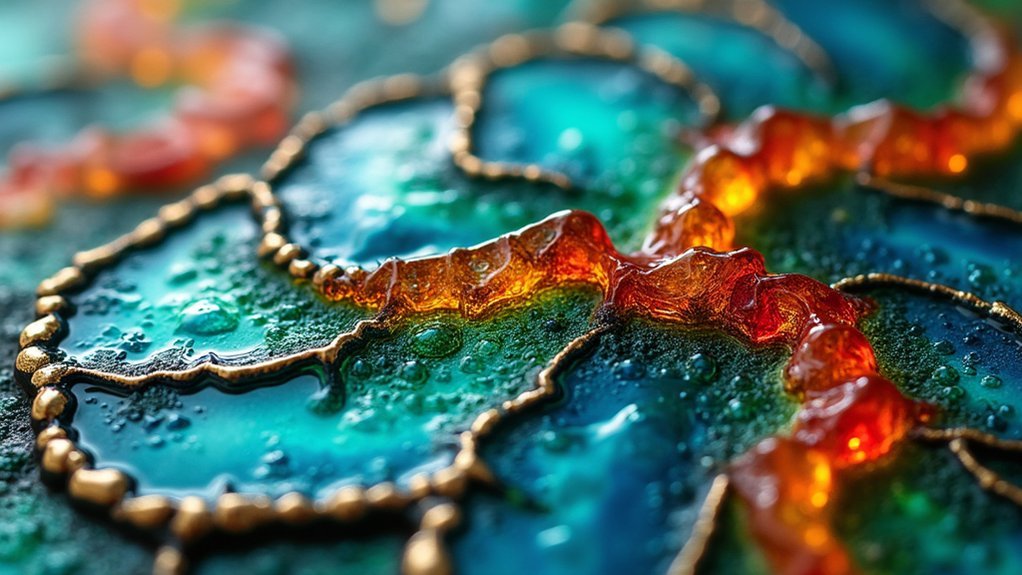
While metal oxides provide the foundation for enamel colors, it’s the precise firing technique that transforms your raw materials into jewelry with extraordinary finish quality.
You’ll need to master temperature control between 1,380 to 1,560°F, where higher heat creates more vibrant colors and superior transparency in your enamel finishes.
Multiple firings are essential for achieving professional texture results:
- First firing bonds enamel to metal base
- Subsequent firings build color depth and complexity
- Six to seven firing cycles create intricate layered designs
- Controlled cooling prevents cracks and enhances smoothness
Your cooling process greatly impacts final texture quality.
Rush the cooling, and you’ll face chips or cracks. Control it properly, and you’ll achieve that polished, professional finish that distinguishes exceptional enamel jewelry from amateur attempts.
Layering Methods for Complex Visual Depth
Once you’ve mastered the firing fundamentals, you can focus on building visual complexity through strategic layering techniques.
These layering methods allow you to create stunning enamel details that capture and reflect light in intriguing ways. You’ll find that champlevé techniques produce raised textures by filling recessed metal areas with enamel, while cloisonné methods use thin metal wires to form compartments for intricate patterns with varying heights.
When you combine transparent and opaque enamels, you’ll achieve striking contrasts that enhance your piece’s dimensional qualities.
Each firing session builds upon the previous layer, and you’ll need multiple firings to reach the complex visual depth that makes enamel jewelry so enthralling.
Master artisans understand that patience during this process guarantees seamless integration between layers.
Surface Treatment Variations From Glossy to Matte
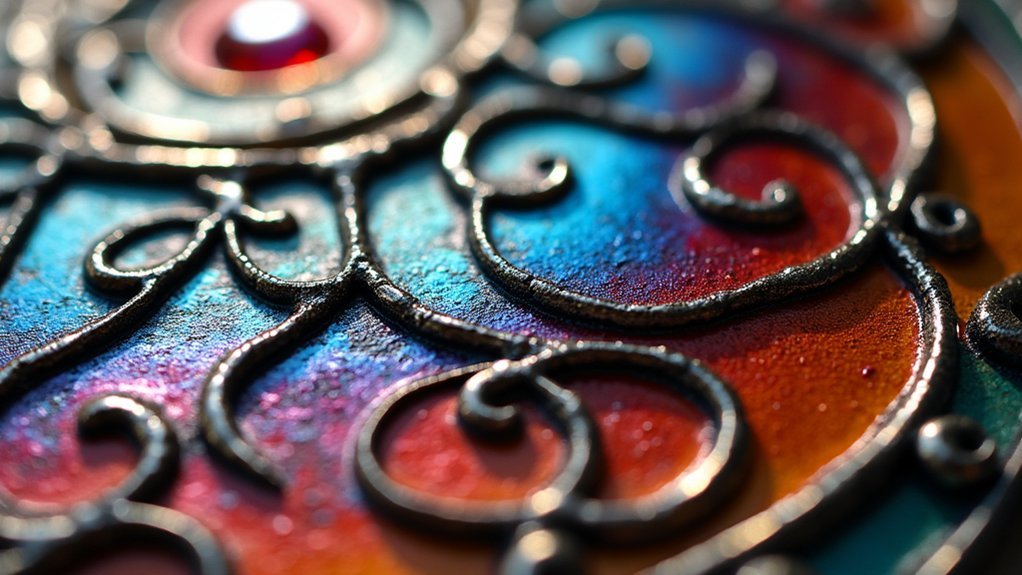
After achieving the desired layered depth, you’ll discover that surface treatments dramatically transform your enamel’s final appearance and character.
Your choice between polished and unpolished finishes determines whether your piece radiates brilliance or whispers elegance.
You can achieve a glossy finish through careful polishing and firing processes, creating a smooth, glass-like surface that reflects light beautifully and enhances color vibrancy.
Alternatively, you’ll find that a matte appearance results from specific finishing techniques, producing softer, more understated aesthetics with muted tones.
Consider these surface treatment options for enhanced visual appeal:
- Basse-taille technique – engraved designs filled with enamel for added depth
- High-polish finishing – maximum light reflection and color brightness
- Matte processing – subdued elegance with refined sophistication
- Textured applications – varied surface patterns for unique character
Frequently Asked Questions
Is Enamel a Good Material for Jewelry?
You’ll find enamel’s an excellent jewelry material because it’s incredibly durable, resistant to tarnish and fading. It offers versatile design options, creates beautiful glass-like finishes, and works well with various metals for lasting pieces.
Why Is Enamel Jewelry so Expensive?
You’re paying for skilled artisans who’ve mastered complex techniques like cloisonné, premium materials including high-grade metals, labor-intensive firing processes, and often unique designs that collectors value for their exceptional craftsmanship.
Does Enamel on Jewelry Wear Off?
You’ll find that high-quality enamel rarely wears off since it’s fused glass, but it can chip from heavy impacts. You’re more likely to see wear on poorly-crafted pieces or vintage jewelry.
What Is the History of Enamel Jewelry?
You’ll find enamel jewelry’s history spans over 5,000 years, starting in ancient Egypt, Greece, and China. It flourished through Byzantine cloisonné techniques, Renaissance refinements, and experienced revivals during Art Nouveau movements.
In Summary
You’ll discover that enamel jewelry’s distinctive texture emerges from the intricate dance between molten glass and metal during firing. When you examine each piece, you’re seeing the result of carefully controlled temperatures, specialized techniques like cloisonné and champlevé, and the artist’s mastery of layering methods. The metal oxides you observe create those stunning color variations, while different surface treatments give you textures ranging from glossy brilliance to subtle matte finishes that can’t be replicated.

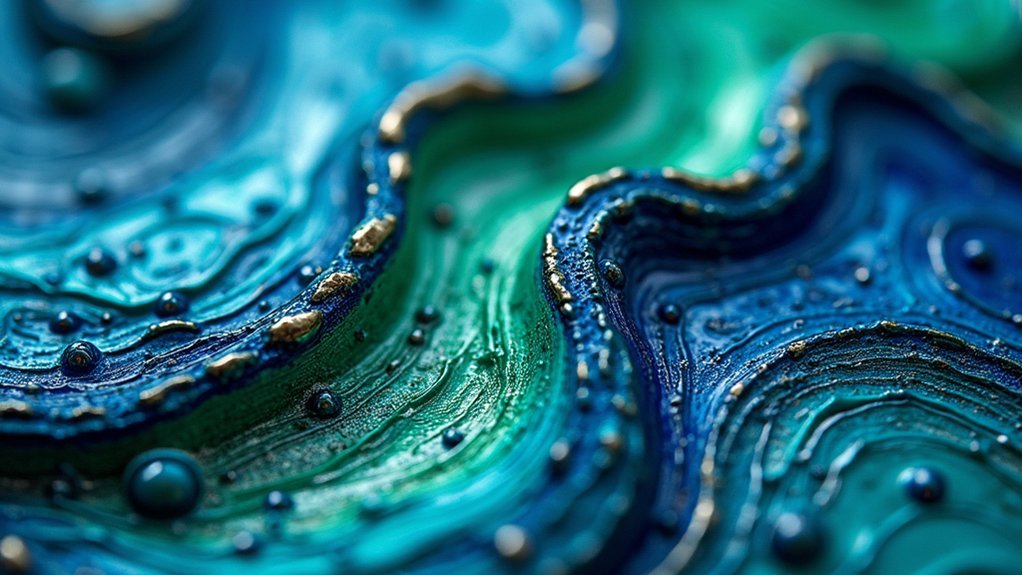



Leave a Reply